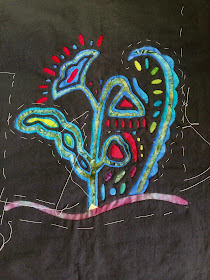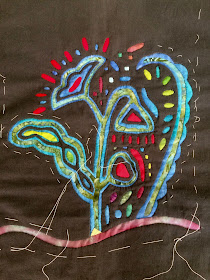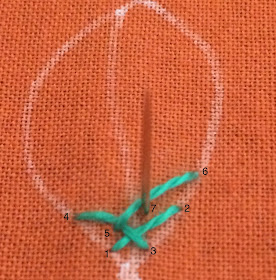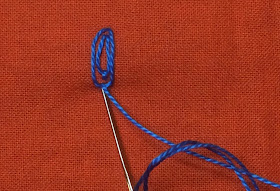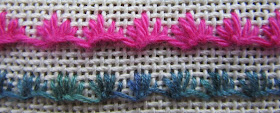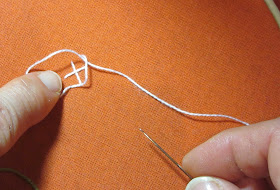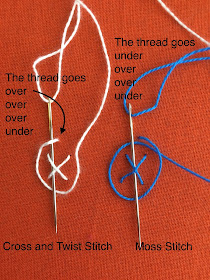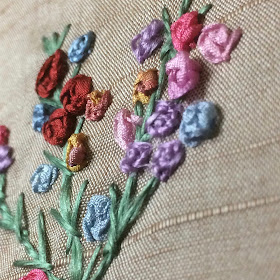10 points if you can spot the difference! Not much progress for Work In Progress Wednesday.
Mola
Last Wednesday
Today, Wednesday
No need to comment!
Mola - Snippets of Interest
Another name for mola (the blouse worn by Cuna Indian women) is dulemor.
(Source: Wikipedia)
Pages
▼
Wednesday, 29 November 2017
Tuesday, 28 November 2017
TAST 155: Beaded Alternating Feather Stitch
TAST stands for Take A Stitch Tuesday which is an online course of stitches on Sharon Boggon's Pintangle. Join in and learn. If you want to do it from scratch, there will be a rerun starting next year.
Read more about TAST here.
Learn how to stitch the Beaded Alternating Feather Stitch here.
As I have explained before, I want all the TAST stitches in one (private) collection and will give them the chronological number in the order I learn them.
So now it is time for Beaded Alternating Feather Stitch, which I will call TAST #155.
(The green seam on the left is upside down. )
On the TAST Reference Chart.
Read more about TAST here.
Learn how to stitch the Beaded Alternating Feather Stitch here.
As I have explained before, I want all the TAST stitches in one (private) collection and will give them the chronological number in the order I learn them.
So now it is time for Beaded Alternating Feather Stitch, which I will call TAST #155.
(The green seam on the left is upside down. )
On the TAST Reference Chart.
Sunday, 26 November 2017
Sunday Stitch School: Lesson 45 - Leaf Stitch
We have stepped on soft Moss, pricked ourselves on Thorns, breathed in the fragrance of Thousand Flowers and Rambling Roses. What else can we do in the garden? Kick Leaves, of course!
Today's stitch at Sunday Stitch School is Leaf Stitch.
Although I have seen several instructions in books, the best one is over at Kimberly Quimet. Her photos are far better than mine, but I will add these anyway.
Mattia tells me the French name is, Point de Fueilla.
The Leaf Stitch is basically a cross worked in the order of 1-2-3-4, as shown below.
The next cross is started inside the first one.
After that you just go on.
This week you have a lot of
Homework:
1) add a row of leaves to the Aida sampler.
Today's stitch at Sunday Stitch School is Leaf Stitch.
Although I have seen several instructions in books, the best one is over at Kimberly Quimet. Her photos are far better than mine, but I will add these anyway.
Mattia tells me the French name is, Point de Fueilla.
The Leaf Stitch is basically a cross worked in the order of 1-2-3-4, as shown below.
After that you just go on.
Homework:
1) add a row of leaves to the Aida sampler.
2) a sprinkling of leaves on the Sunday Stitch School sampler, if you please,
and finally
3) brighten up this wet asphalt with some fallen leaves
Friday, 24 November 2017
Friday Homework for Lesson 44: Mille Fleur Stitch
Here is my homework for stitch #44, Mille Fleur.
I wanted it to look like the background of flowers on a tapestry.
Later I will add something in the centre, either a bead or some French Knots.
I wanted it to look like the background of flowers on a tapestry.
Later I will add something in the centre, either a bead or some French Knots.
Wednesday, 22 November 2017
WIPW - Taking Shape?
Work In Progress Wednesday from a chilly Tokyo.
Progress on my
Mola
is getting visible as the Mola style begins to take shape.
Red has a lot to do with it, I think!
Mola - Snippets of Interest
Typical Mola colours such as burgundy, orange or black are referring to the vegetable colours used for the body painting of the past.
(Source PANAMA MOLA: Renate & Marian Wetter)
Progress on my
Mola
is getting visible as the Mola style begins to take shape.
Red has a lot to do with it, I think!
Mola - Snippets of Interest
Typical Mola colours such as burgundy, orange or black are referring to the vegetable colours used for the body painting of the past.
(Source PANAMA MOLA: Renate & Marian Wetter)
Tuesday, 21 November 2017
TAST 154: Feather and Chain Stitch
TAST stands for Take A Stitch Tuesday which is an online course of stitches on Sharon Boggon's Pintangle. Join in and learn. If you want to do it from scratch, there will be a rerun starting next year.
Read more about TAST here.
Learn Feather and Chain Stitch here.
As I have explained before, I want all the TAST stitches in one (private) collection and will give them the chronological number in the order I learn them.
So now it is time for Feather and Chain Stitch, which I will call TAST #154.
Turn the work and look at it from this angle and you get rough waves on a stormy ocean. Or is it Nessy sticking her head out of Lock Ness? Or is it just a pretty design?
On the TAST Reference Chart
This is an easy and great stitch!
Read more about TAST here.
Learn Feather and Chain Stitch here.
As I have explained before, I want all the TAST stitches in one (private) collection and will give them the chronological number in the order I learn them.
So now it is time for Feather and Chain Stitch, which I will call TAST #154.
Turn the work and look at it from this angle and you get rough waves on a stormy ocean. Or is it Nessy sticking her head out of Lock Ness? Or is it just a pretty design?
On the TAST Reference Chart
This is an easy and great stitch!
Sunday, 19 November 2017
Sunday Stitch School - Lesson 44: Mille Fleur Stitch
It is time for another lesson of embroidery stitches here at Sunday Stitch School.
Today's stitch is an unusual one. The name, Mille Fleur Stitch, leads us to think it is a French stitch. However, I found it in Eva Köhlmark's Broderiboken, which is written in Swedish. I have not seen this stitch before, nor found its name anywhere else, in any book or on the internet.
I wonder where it got its name from. Obviously it has nothing to do with Millefleurs, the expression used for the background style of flowers seen on Flemish and French tapestries, e.g. The Lade and the Unicorn.
William Morris also used Mille Fleur; a sprinkling of flowers in the background of his designs.
Furthermore, Mille Fleur is the name of some carpets from Cashmere with floral designs.
You can read about the topics above, in this link: millefleur
Now, Eva Köhlmark's Mille Fleur Stitch is simply a tripple Lazy Daisy Stitch. When two LD stitches are work over each other you get the Berry Stitch (TAST 47), in Mille Fleur you add one more detached Chain Stitch.
Anyone who has knowledge of this stitch, please leave a message in the Comment Box.
Updated:
Annet gave me this YouTube link where you can see how great the stitch looks when worked in variegated thread. In the video the stitch is called Triple Detached Chain Stitch.
Work it like this:

Make one Chain Stitch.

Anchor it.
Make a new stitch outside the small Chain Stitch, and anchor it in the same way.
Repeat with a third stitch.
It is easy to work, but hard to get even. Look at the unevenness on my Aida sampler.
As you can see, different colored threads can be mixed.
On my (new) SSS Reference Chart.
Homework:
Make something with the red fabric and goodies from the 'sweet box'.
Friday, 17 November 2017
Friday Homework for Lesson 43: Moss Stitch
Welcome to Kyoto where I saw this fallen leaf on a moss carpet in a temple garden.
The knot on the Moss Stitch is slightly complicated. If you don't like knotty stitches I'd recommend the Cross and Twist Stitch that can be found in Mary Thomas's Dictionary of Embroidery Stitches, page 76. The knot is not as prominent, but still looks good.
The knot on the Moss Stitch is slightly complicated. If you don't like knotty stitches I'd recommend the Cross and Twist Stitch that can be found in Mary Thomas's Dictionary of Embroidery Stitches, page 76. The knot is not as prominent, but still looks good.
Wednesday, 15 November 2017
WIPW - Back to Work
Wednesday, and it means it is time for a progress report, (Work In Progress Wednesday).
Mola
Compare the pictures to see the progress
I am still most uncomfortable with the work - I really don't know what I am doing! The red has added a touch of 'Mola style', I guess, but the rest does not look anything like the beautiful work of the Cuna Indians, or Ms Fumiko Nakayama - yet. I will just have to trudge along...
Mola - Snippets of Interest
The Cuna Indians use many kinds of motifs, not only tropical birds and animals or exotic plants, but religious symbols, rockets, sporting events, as well as illustrations from advertisements, for their Molas.
Many Cuna Indians are illiterate and the letters of the alphabet are simply seen as decorative symbols, so letters might be missing or turned upside down.
A Swedish match-box with a parrot and the text: 'Made by Jönköping-Vulcans T.F. AB Sweden' was the inspiration for a Mola, but the text became: 'ADEBYJOPINGS&VULCANSTFABSWEDEN'.
(Source: Broderiboken - Eva Köhlmark)
I found a similar reference to a Swedish matchbox parrot Mola here.
Mola
Compare the pictures to see the progress
(No, I did not dye the fabric! The difference in colour is a trick of my camera!)
Mola - Snippets of Interest
The Cuna Indians use many kinds of motifs, not only tropical birds and animals or exotic plants, but religious symbols, rockets, sporting events, as well as illustrations from advertisements, for their Molas.
Many Cuna Indians are illiterate and the letters of the alphabet are simply seen as decorative symbols, so letters might be missing or turned upside down.
A Swedish match-box with a parrot and the text: 'Made by Jönköping-Vulcans T.F. AB Sweden' was the inspiration for a Mola, but the text became: 'ADEBYJOPINGS&VULCANSTFABSWEDEN'.
(Source: Broderiboken - Eva Köhlmark)
I found a similar reference to a Swedish matchbox parrot Mola here.
Tuesday, 14 November 2017
TAST 153: Rosette of Thorns Stitch
TAST stands for Take A Stitch Tuesday which is an online course of stitches on Sharon Boggon's Pintangle. Join in and learn. If you want to do it from scratch, there will be a rerun starting next year.
Read more about it here.
Learn Rosette of Thorns here.
As I have explained before, I want all the TAST stitches in one (private) collection and will give them the chronological number in the order I learn them.
So now it is time for Rosette of Thorns Stitch, which I will call TAST #153.
Innocent looking, but not the easiest of stitches.
Read more about it here.
Learn Rosette of Thorns here.
As I have explained before, I want all the TAST stitches in one (private) collection and will give them the chronological number in the order I learn them.
So now it is time for Rosette of Thorns Stitch, which I will call TAST #153.
Innocent looking, but not the easiest of stitches.
Sunday, 12 November 2017
Sunday Stitch School - Lesson 43: Moss Stitch
For today's botanical lesson we will make an excursion to Saiho-ji Temple in Kyoto.
It is often called Kokedera, which would be 'Moss Temple' in English.
Read more about Saiho-ji, the regulations for entering, and look at pictures of the green 'carpet' here.
Now for the stitch. I found Moss Stitch in A - Z of Embroidery Stitches 2. For those who have this book and can compare, you find that I have experimented with how to loop the thread, as you can see in my pictures below:

Take the thread out above the cross.
Twist the thread around your finger to make a loop :
Place the loop around the cross.
Insert the needle under the cross, but don't bite any of the fabric.
Pull the loop tight till you have a knot, and insert the needle below the cross to anchor.
You have made one Moss Stitch.
Make a zillion more and you have a moss carpet as lush as those of a Kyoto temple garden.
This is my 'Aida Moss Garden'!


It is often called Kokedera, which would be 'Moss Temple' in English.
Read more about Saiho-ji, the regulations for entering, and look at pictures of the green 'carpet' here.
Now for the stitch. I found Moss Stitch in A - Z of Embroidery Stitches 2. For those who have this book and can compare, you find that I have experimented with how to loop the thread, as you can see in my pictures below:
First make a cross stitch.

Take the thread out above the cross.
Twist the thread around your finger to make a loop :
Place the loop around the cross.
Insert the needle under the cross, but don't bite any of the fabric.
Pull the loop tight till you have a knot, and insert the needle below the cross to anchor.
You have made one Moss Stitch.
Make a zillion more and you have a moss carpet as lush as those of a Kyoto temple garden.
This is my 'Aida Moss Garden'!
Updated later:
As far as I know there is no Swedish name for this stitch.
Mattia, who always helps to find French names for the stitches, points to the French translation of Mary Thomas's Dictionary of Embroidery Stitches, where there is a stitch called Point de Croix Bouclé.
I had a look in my MTDoES in English. There is no stitch under the name Moss Stitch, but a similar looking stitch called Cross and Twist Stitch.
However, the knot is made differently.
Have a look:
The Cross and Twist Stitch is far easier to make! I wish I had seen it earlier! Thank you, Mattia, for pointing me in this direction!
Homework:
1) You need to make a new Reference Chart as the first is filled with Stitches 1 - 42
2) On a red background make a moss garden with linen thread.
Friday, 10 November 2017
Friday Homework for Lesson 42: Rambling Rose Stitch
Late again, but not too late. Here is my homework for Sunday Stitch School and the Rambling Rose Stitch.
I started with a base of Thorn Stitch, then added the roses in various kinds of silk thread and ribbons.
The stitches have this 3D effect.
Wednesday, 8 November 2017
WIPW - Mola Pouch
Work In Progress Wednesday today reports about a shelved Mola and a completed Mola.
This Mola bag
was designed, made up and completed into a small pouch during the week.
Had I had more time on my hands I would have slit more holes and displayed the more of the fabric lurking underneath the green top. As it was, I had to finish it quickly; it is a present for someone whose birthday is tomorrow.
A close-up of the rough stitching! The result of hasty work!
MOLA - Snippets of Interest
Sometimes the reverse appliqué on original Mola is made through more than one layer of fabric - this tricks the eye to think a fabric is closer to the surface than it really is.
(Source: Stitch, Fabric & Thread by Elizabeth Healey)
This Mola bag
was shelved and no progress whatsoever was made.
However, this Mola pouch
Had I had more time on my hands I would have slit more holes and displayed the more of the fabric lurking underneath the green top. As it was, I had to finish it quickly; it is a present for someone whose birthday is tomorrow.
MOLA - Snippets of Interest
Sometimes the reverse appliqué on original Mola is made through more than one layer of fabric - this tricks the eye to think a fabric is closer to the surface than it really is.
(Source: Stitch, Fabric & Thread by Elizabeth Healey)
